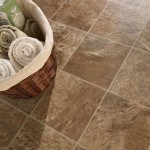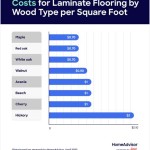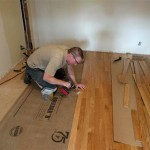Can You Lay Vinyl Flooring Over Laminate?
The question of whether vinyl flooring can be installed directly over existing laminate flooring is a common one for homeowners considering a floor renovation. The answer is nuanced and depends on several factors relating to both the existing laminate and the planned vinyl flooring. This article will explore the conditions under which such an installation is feasible, the potential benefits and drawbacks, and the preparatory steps necessary to ensure a successful outcome.
Vinyl flooring, renowned for its durability, water resistance, and ease of maintenance, presents an attractive alternative to laminate. Laminate, while aesthetically pleasing and relatively affordable, can be susceptible to moisture damage and may show wear and tear over time. Therefore, the appeal of covering laminate with vinyl is understandable. However, simply laying vinyl over laminate without proper assessment and preparation can lead to a host of problems, including uneven surfaces, trapped moisture, and ultimately, premature flooring failure.
Assessing the Existing Laminate Floor
Before considering a vinyl overlay, a thorough evaluation of the existing laminate floor is crucial. This assessment should focus on several key areas:
Stability: The laminate flooring must be structurally sound. Loose, warped, or significantly damaged laminate boards are not suitable as a subfloor. Any movement or instability in the laminate will telegraph through the vinyl, resulting in an uneven and potentially unstable surface. Addressing any underlying structural issues with the subfloor beneath the laminate is vital before proceeding. This may involve replacing damaged sections of the subfloor, securing loose boards, or leveling uneven areas.
Levelness: A level surface is paramount for a successful vinyl installation. Significant undulations or height variations in the laminate floor will be visible and felt through the vinyl. Small imperfections can sometimes be addressed with self-leveling compound, but larger variations may necessitate the removal of the laminate. Using a long level (at least 6 feet) to check for dips and humps across the floor is recommended. Any deviations greater than 3/16 inch over a 6-foot span should be carefully evaluated.
Moisture: Laminate flooring is vulnerable to moisture damage. Any signs of water stains, swelling, or mold indicate a moisture problem that must be addressed before installing vinyl. Vinyl flooring, while water-resistant, will not prevent moisture from rising from below. Trapped moisture can lead to mold growth, adhesive failure, and degradation of both the laminate and the vinyl. Conducting a moisture test is essential. A simple test involves taping a plastic sheet (e.g., a garbage bag) to the laminate floor for 24-48 hours. If moisture accumulates under the plastic, a moisture issue exists.
Cleanliness: Thoroughly cleaning the laminate floor is essential to ensure proper adhesion of the vinyl. Remove all dirt, dust, debris, and any remnants of old waxes or polishes. A degreasing cleaner may be necessary to remove stubborn residues. After cleaning, rinse thoroughly and allow the floor to dry completely before proceeding with any further preparation.
Types of Vinyl Flooring Suitable for Overlaying Laminate
The type of vinyl flooring chosen also plays a significant role in the success of an overlay installation. Certain types are more forgiving of minor imperfections and are better suited for this application:
Luxury Vinyl Plank (LVP): LVP typically has a thicker construction than sheet vinyl or standard vinyl tiles, providing more cushioning and hiding minor imperfections in the laminate. Click-lock LVP, in particular, can be a good option as it "floats" over the laminate, minimizing the impact of minor variations in the underlying surface. However, ensuring the laminate is sufficiently level and stable is still crucial.
Luxury Vinyl Tile (LVT): Similar to LVP, LVT offers durability and resilience. It is often available in thicker formats, making it more suitable for overlaying laminate. The individual tile format allows for some flexibility in accommodating minor height variations, though again, proper subfloor preparation is essential.
Sheet Vinyl: Sheet vinyl is generally not recommended for overlaying laminate unless the laminate is exceptionally level and smooth. Its thin construction makes it highly susceptible to telegraphing any imperfections from the underlying surface. Additionally, installing sheet vinyl requires careful handling and precise cutting to avoid seams, which can be challenging on an uneven surface.
Adhesive selection is also critical. Follow the vinyl flooring manufacturer's recommendations for the appropriate adhesive type for the specific vinyl product and the laminate substrate. Using the wrong adhesive can result in poor adhesion, bubbling, and eventual flooring failure.
Preparation Steps for a Successful Installation
Assuming the existing laminate meets the criteria for stability, levelness, and dryness, and the appropriate vinyl flooring has been selected, the following preparation steps are necessary to ensure a successful installation:
Acclimation: Allow both the vinyl flooring and the adhesive to acclimate to the room's temperature for at least 48 hours before installation. This allows the materials to expand or contract, minimizing the risk of issues like gaps or buckling after installation.
Seam Treatment (If Applicable): If the laminate floor has noticeable seams or gaps, filling them with a suitable patching compound is recommended. This will create a smoother surface and prevent the vinyl from dipping or cracking along the seams.
Underlayment (Optional): While not always necessary, an underlayment specifically designed for vinyl flooring can provide additional cushioning, sound insulation, and moisture protection. Choose an underlayment that is compatible with both the vinyl flooring and the laminate substrate.
Proper Adhesion Techniques: Follow the vinyl flooring manufacturer's instructions precisely when applying the adhesive. Use the recommended trowel notch size and spread the adhesive evenly. Allow the adhesive to tack up according to the manufacturer's guidelines before laying the vinyl. Roll the vinyl floor thoroughly with a floor roller to ensure proper adhesion and remove any air pockets.
Expansion Gaps: Leave appropriate expansion gaps around the perimeter of the room and around any fixed objects (e.g., pipes, door frames). These gaps allow for the natural expansion and contraction of the flooring without causing buckling or cracking.
In summary, while it is possible to lay vinyl flooring over laminate, it requires careful consideration and meticulous preparation. A thorough assessment of the existing laminate floor's condition, selection of the appropriate vinyl flooring type, and adherence to proper installation techniques are crucial for a successful and long-lasting result. Ignoring these factors can lead to costly repairs and premature flooring failure.
Before undertaking such a project, it is advisable to consult with a flooring professional who can assess the specific conditions of your existing floor and provide tailored recommendations. They can identify potential problems that may not be immediately apparent and ensure that the installation is carried out correctly. While DIY installation is possible, professional installation often provides a higher level of assurance and can save time and money in the long run by preventing costly mistakes.
Furthermore, building codes and manufacturer warranties may impose specific requirements for flooring installations. Failure to comply with these requirements could void warranties or result in code violations. Therefore, researching local building codes and reviewing the manufacturer's warranty information for both the laminate and the vinyl flooring is essential.
Choosing to install vinyl over laminate can be a viable option for homeowners seeking an affordable flooring upgrade. However, approaching the project with a clear understanding of the potential challenges and the necessary preparation steps is paramount to achieving a successful and aesthetically pleasing outcome.
Potential Problems and Considerations
Even with careful planning and execution, certain potential problems can arise when installing vinyl over laminate:
Telegraphing: As mentioned earlier, any imperfections in the underlying laminate can telegraph through the vinyl, resulting in an uneven surface. While thicker vinyl flooring and underlayment can help mitigate this issue, they may not completely eliminate it.
Increased Floor Height: Adding a layer of vinyl on top of laminate will increase the overall floor height. This can create transitions issues with adjacent flooring, require modifications to doors to ensure they can still open and close freely, and potentially affect appliance clearances.
Moisture Issues: If moisture is present in the subfloor or the laminate itself, covering it with vinyl will exacerbate the problem. Trapped moisture can lead to mold growth, adhesive failure, and degradation of both the laminate and the vinyl. Addressing any moisture issues before installing vinyl is critical.
Adhesive Failure: Using the wrong adhesive, failing to prepare the surface properly, or installing the vinyl in a high-moisture environment can lead to adhesive failure. This can result in bubbling, lifting, and eventual separation of the vinyl from the laminate.
These potential problems highlight the importance of careful assessment, thorough preparation, and adherence to best practices when installing vinyl over laminate. Taking the time to address these concerns proactively can significantly increase the likelihood of a successful and long-lasting flooring installation.

Can I Install Vinyl Tiles Over Laminate Flooring Comprehensive Guide

Can I Lay Vinyl Over Laminate Flooring Metwest Building Supplies Blog

Can I Install Vinyl Tiles Over Laminate Flooring Comprehensive Guide

Can I Overlay Vinyl Flooring Over Parquet Singapore

Installing Luxury Vinyl Floors Over Engineered Hardwood Honey Built Home

Should You Install Vinyl Floor Over Tile

How To Install Vinyl Flooring Over Hardwood Floors Wood Floor Fitting

Laying Vinyl Planks The Right Way Expert Guide By Fantastic Handyman

How To Install Laminate Or Vinyl Plank Flooring Over Old Hardwood

How To Install Vinyl Flooring Over Hardwood Floors Wood Floor Fitting
Related Posts








